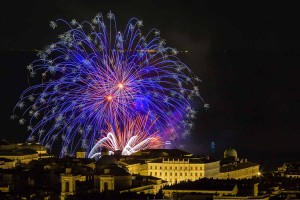
©Bigstock.com/bluebeat76
August is commonly seen as the holiday season of the Italian public. During this time, natives from north to south surge to predominantly cooler areas spending their holidays preferably on the beach or in the mountains. The cities appear almost empty during this month. Some stores are closed, even a few tourist attractions only operate in a reduced capacity. This holiday season is frequently seen as synonymous with Ferragosto, which is actually one of Italy’s most important religious and family-oriented holidays; a time of going on holiday that also marks the turn of the summer.
Europe’s oldest public holiday?
The Catholic Church celebrates the Assumption of Mary on August 15th, one of Italy’s most important religious holidays. Ferragosto itself, however, only became synonymous with this religious feast much later. Its origins can be traced back much further, even to pre-Christian times. After defeating Cleopatra and Marcus Antonius at Alexandria and Actium, the first Roman emperor Augustus held a three-day feast on the 13th, 14th and 15th of August in 29 BC to celebrate the conquest of Egypt. Originally, all three anniversary dates were considered festivities; later, only August 15th was celebrated as “feriae Augusti” in the entire Roman Empire. The introduction of Christianity turned believers’ prayers towards the Virgin Mary. It is believed that August 15th was set as the date of the Assumption of Mary during the 18th century, but it only became a religious holiday in 1950 after a decree of Pope Pius XII. Still, it is widely assumed that Ferragosto is the oldest holiday in Europe still celebrated today.
The original festivities
In ancient times, there were two reasons for Ferragosto to be celebrated. On one hand, Augustus pursued political goals, on the other hand, he wanted to combine existing festivities to one big holiday seasons. Thus, he introduced a time for recreation over several days, the so-called “Augustali”, in 8 BC. You certainly won’t be surprised that several feasts and ceremonial acts were held throughout the entire empire. Festively decorated roads and houses captured the excited mood of the public. All horses and draught animals were released from work for the time being. Being properly adorned as well, they were used for massive, spectacular races that got the masses wild. Variations of such huge events still exist today, e.g. the Palio di Siena.
Ferragosto today
When Pope Pius XII declared the Assumption of Mary a public holiday, the religious aspect of Ferragosto reached its peak. Numerous Catholic feasts and ceremonies came with this festive days, especially in its initial years. However, its meaning has since changed. While there are still some glorious, breathtakingly beautiful processions of the Virgin Mary, mostly in southern Italy, August 15th and the days before and after have since become a time that is spent with the loved ones. Traditionally, if they aren’t on holiday already, the Italians go on day trips to the coast or into the mountains for an abundant picnic with the family. First come, first served – not only the motorways are packed on this day. The big feast in the restaurants and hotels with opulent buffets, fine regional specialties and multi-course menus is just as important a part of the day. The evening is capped off with a massive firework display that many Italians enjoy while sitting at a bonfire.
Holidays for Italians in Italy
August is the main holiday season of the Italian public. Many even see this month as a virtually compulsive time-off and flock to the beaches or the mountains. The cities and villages appear equally empty, while the slightly cooler destinations become rather crowded. If you’re looking for a lively stay and enjoy mingling with locals, you will love the hustle, the many festivities, and the atmosphere of genuine fun and excitement in the coastal regions. The larger cities, however, quiet down, especially around August 15th, with museums being the exception to the rule. Longer opening hours, promotions and discount around Ferragosto attract distinctly more visitors having even increased revenues over the last years. Many stores, restaurants, cinemas, theatres, workshops, some tourist attractions, and even a few local authorities outside the coastal and mountainous holiday regions are partly or even fully closed.
Whether you’d like to sample the lively atmosphere in the Ferragosto holiday region or prefer booking your stay in one of the other eleven months, ZAINOO has travel tips for all of Italy. Have fun browsing and see you soon!